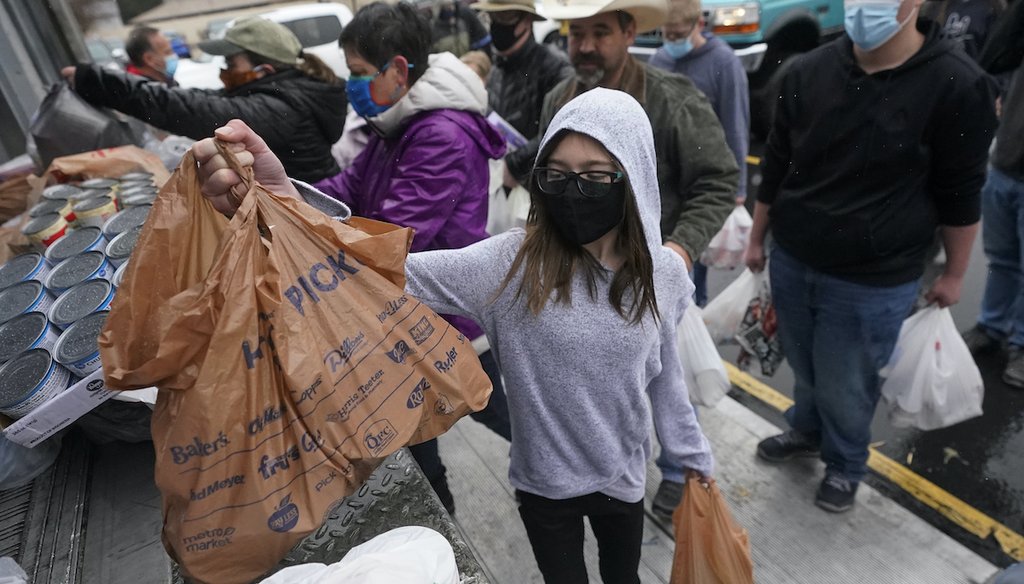Stand up for the facts!
Our only agenda is to publish the truth so you can be an informed participant in democracy.
We need your help.
I would like to contribute

Food donations are brought to a collection site during the Feed Utah food drive Saturday, March 20, 2021, in Sandy, Utah. (AP)
Fact-checking Biden’s claim about hunger 'sharply' dropping
If Your Time is short
-
The number of people who told the Census Bureau that they sometimes or often don’t have enough food to eat has been declining in recent months.
-
Multiple factors have contributed to the decline in food insecurity, including more people working, schools reopening and increases in federal food assistance programs.
-
The American Rescue Plan signed by Biden in March includes about $12 billion in food assistance.
President Joe Biden credits the American Rescue Plan for helping Americans recover from the pandemic and economic fallout, including those who have experienced hunger.
"The Rescue Plan is delivering food and nutrition assistance to millions of Americans facing hunger," Biden said May 5. "And hunger is already sharply down in the United States."
Biden signed the American Rescue Plan on March 11, so we wondered if the legislation had already caused hunger to decline "sharply" less than two months later.
We found that the plan’s stimulus checks and food programs have helped. But there are other factors that have eased hunger, including school reopenings, a rebounding economy and previous aid.
Fewer people say they lack food
The pandemic caused school closures and higher unemployment, driving up the numbers of people who needed help obtaining food. A Northwestern University study estimates that at one point during the pandemic, nearly 23% of households in the U.S. experienced food insecurity.
The White House cited a Washington Post article that cited data from the Census Bureau’s Household Pulse Survey. The Census designed the survey to collect data on how people’s lives have been impacted by the pandemic, initially collecting data every week and then every two weeks. One of the questions respondents are asked is whether they sometimes or often did not have enough to eat in the previous seven days. (Experts cautioned against using this survey to compare hunger from different surveys before the pandemic, but told us it is useful to compare the current survey’s data during different weeks.)
Adult food insecurity in the U.S. declined 43% from December to the most recent data for April. The percentage who reported food security was 10.7% during the first two weeks in March and then fell to 8.8% later in March after the bill was signed into law.
Diane Whitmore Schanzenbach, a Northwestern University economist, said the latest round of stimulus checks were a major driver in the decline in hunger between the first and second half of March.
"The economy is improving, and employment is increasing, which is also helping the numbers, but the big drop is most likely explained by the stimulus/relief payments," she said.
American Rescue Plan includes multiple provisions for food assistance
Starting in spring 2020, the federal government took action to expand food assistance as a result of the pandemic. Biden continued on that path, including the $12 billion in food assistance in the American Rescue Plan.
Here’s a look at some of the major food assistance programs:
-
The American Rescue Plan maintains a 15% increase in Supplemental Nutrition Assistance Program (SNAP) benefits through September, which provides about $28 more per person, per month. This program is an extension of the increase from the Consolidated Appropriations Act signed by President Donald Trump in December.
-
The USDA announced April 1 that it would provide $1 billion per month in additional assistance to the lowest income households on SNAP.
-
The American Rescue Plan includes $900 million for the Women, Infants and Children nutrition program. Some of the funding includes temporarily increasing the voucher for fruits and vegetables. Many states opted into this program in March and April.
-
Aid through a Pandemic-EBT program was established in March 2020 through the Families First Coronavirus Response Act to provide money for low-income families for children missing meals due to school closures. The American Rescue Plan extends the program through the summer.
Experts told us that it wasn’t just the recent American Rescue Plan that contributed to the decline in hunger.
"The unemployment rate is the single biggest correlation to food insecurity in America," said Joel Berg, CEO of Hunger Free America.
Scott Winship, a scholar at the conservative American Enterprise Institute, said like the food insecurity data, the poverty data shows a big decline in March, so that’s consistent with a drop in hunger.
"The decline in food insecurity and poverty both began before President Trump signed the $2.3 trillion December relief bill into law," Winship said. "I think the American Rescue Plan could be responsible for the more recent decline though."
The economy has also been rebounding since pandemic rules have loosened, said Michael Tanner, an expert on poverty at the libertarian Cato Institute.
"The number of people who are food insecure has declined, but we just passed this thing," Tanner said, referring to the American Rescue Plan. "The idea that is what is having the impact seems to stretch credulity a bit."
Our ruling
Biden said after the American Rescue Plan’s food and nutrition assistance, "hunger is already sharply down in the United States."
The number of adults who have told the Census that they sometimes or often don’t have enough food in the past week declined this spring. The decline coincided with the American Rescue Plan, signed into law in March, which included a new round of stimulus checks and food assistance programs.
But there are a lot of moving parts that have contributed to the hunger decline, including previous legislation, schools reopening and the recovering economy.
We rate this statement Mostly True.
RELATED: Why it’s hard to link school reopenings to Biden’s efforts
RELATED: Fact-checking Joe Biden on the American Rescue Plan
RELATED: Joe Biden’s plan to cut child poverty by half: What you need to know
Our Sources
White House, Remarks by President Biden on His Administration’s Implementation of the American Rescue Plan, May 5, 2021
Census, Household Pulse Survey Data Tables including food scarcity, Accessed May 6, 2021
U.S. Department of Agriculture, WIC opt-in states for temporary benefit, Accessed May 7, 2021
U.S. Department of Agriculture, Fact sheet about American Rescue Plan, March 22, 2021
U.S. Department of Agriculture, Press release about SNAP, April 1, 2021
U.S. Department of Agriculture, Press release about SNAP, March 22, 2021
Center on Budget and Policy Priorities’ Claire Zippel, Twitter thread, May 5, 2021
Center on Budget and Policy Priorities, Hardship Rates Dropped in March, But Many Still Borrow to Get By, April 9, 2021
CNN, Fact-checking Biden's first joint address to Congress, April 29, 2021
Washington Post, Biden’s economy shows strength, but recovery is far from complete, April 26, 2021
PolitiFact, Fact-checking Biden's rollout of plan to address 'twin crises' of economy, pandemic, Jan. 15, 2021
Email interview, Emilie Simons, White House spokesperson, May 6, 2021
Email interview, Matt Herrick, U.S. Department of Agriculture spokesperson, May 7, 2021
Email interview, Diane Whitmore Schanzenbach, Northwestern University economist, May 6, 2021
Telephone interview, Joel Berg, CEO of Hunger Free America, May 6, 2021
Telephone interview, Michael Tanner, CATO Institute senior fellow, May 6, 2021
Email interview, Scott Winship, American Enterprise Institute, resident Scholar and director of Poverty Studies, May 7, 2021
Browse the Truth-O-Meter
More by Louis Jacobson
Fact-checking Biden’s claim about hunger 'sharply' dropping
Support independent fact-checking.
Become a member!
In a world of wild talk and fake news, help us stand up for the facts.







































